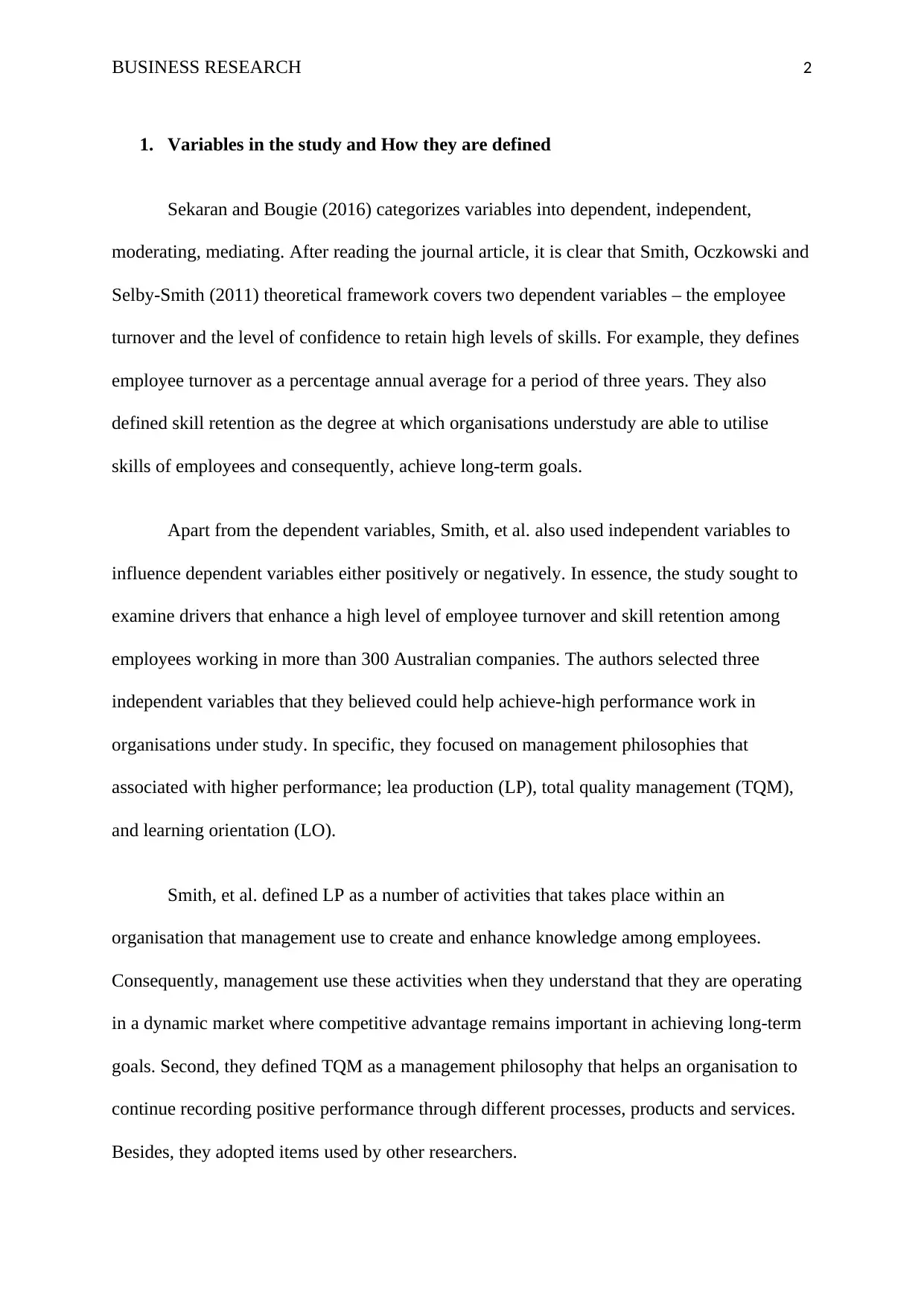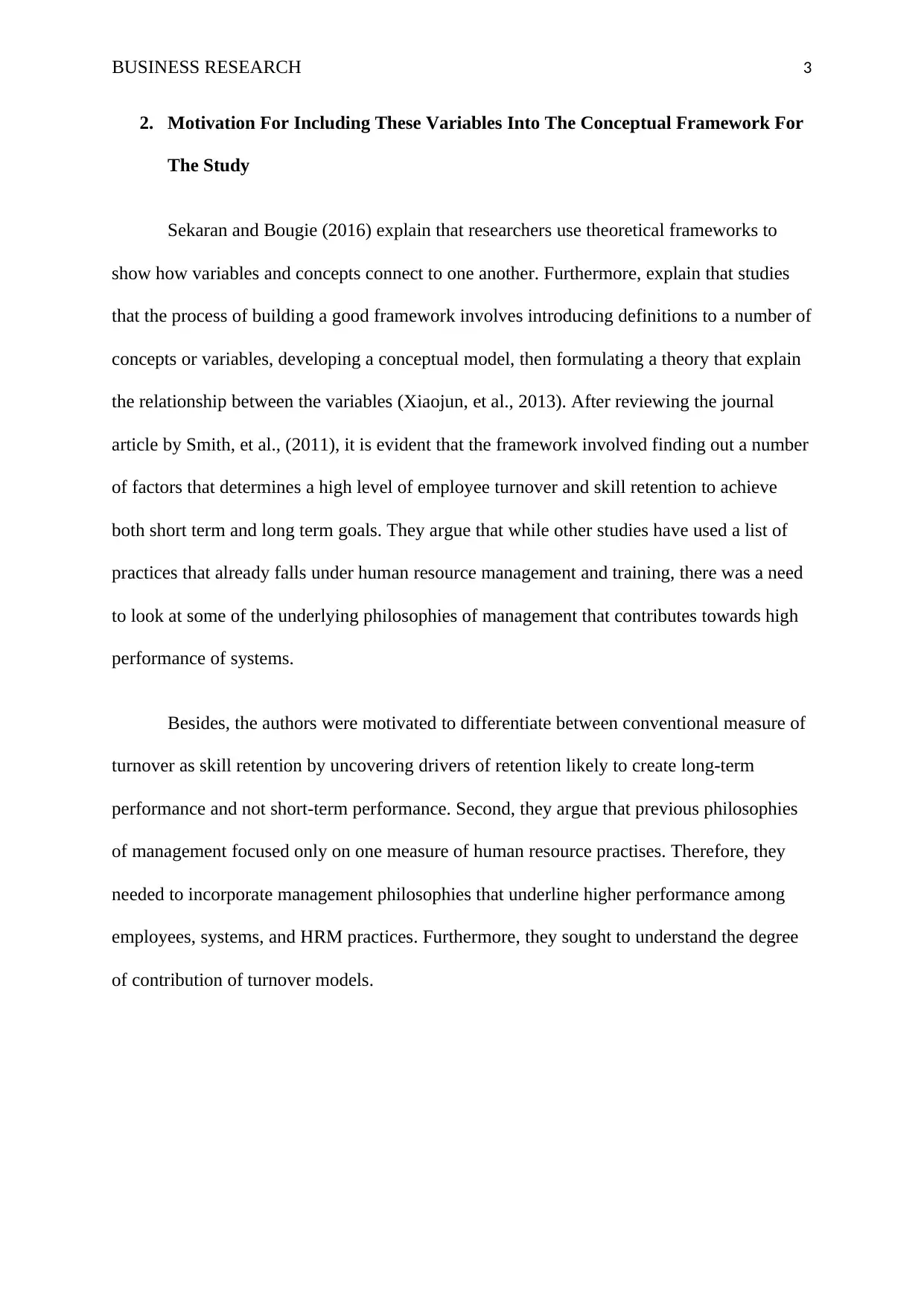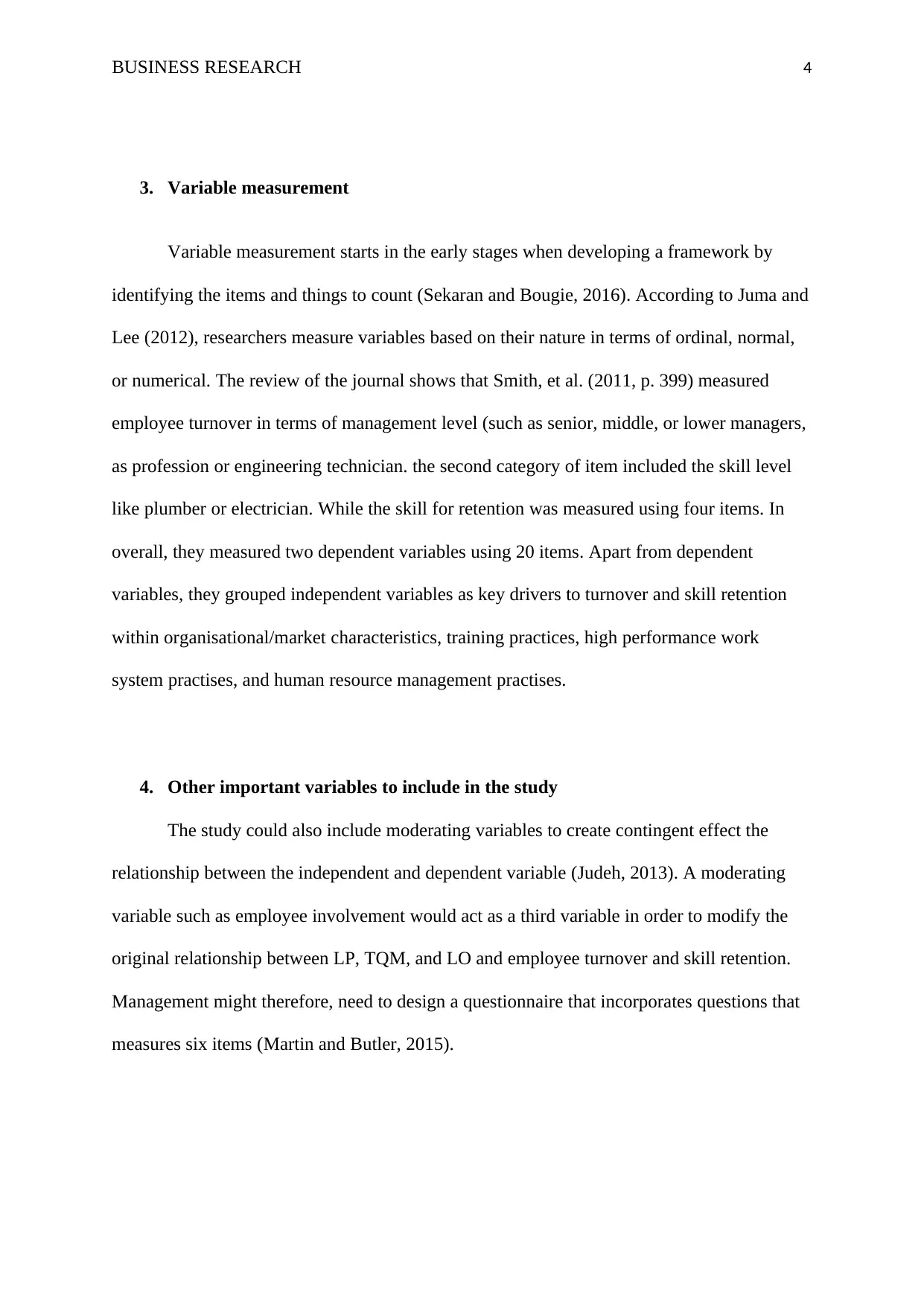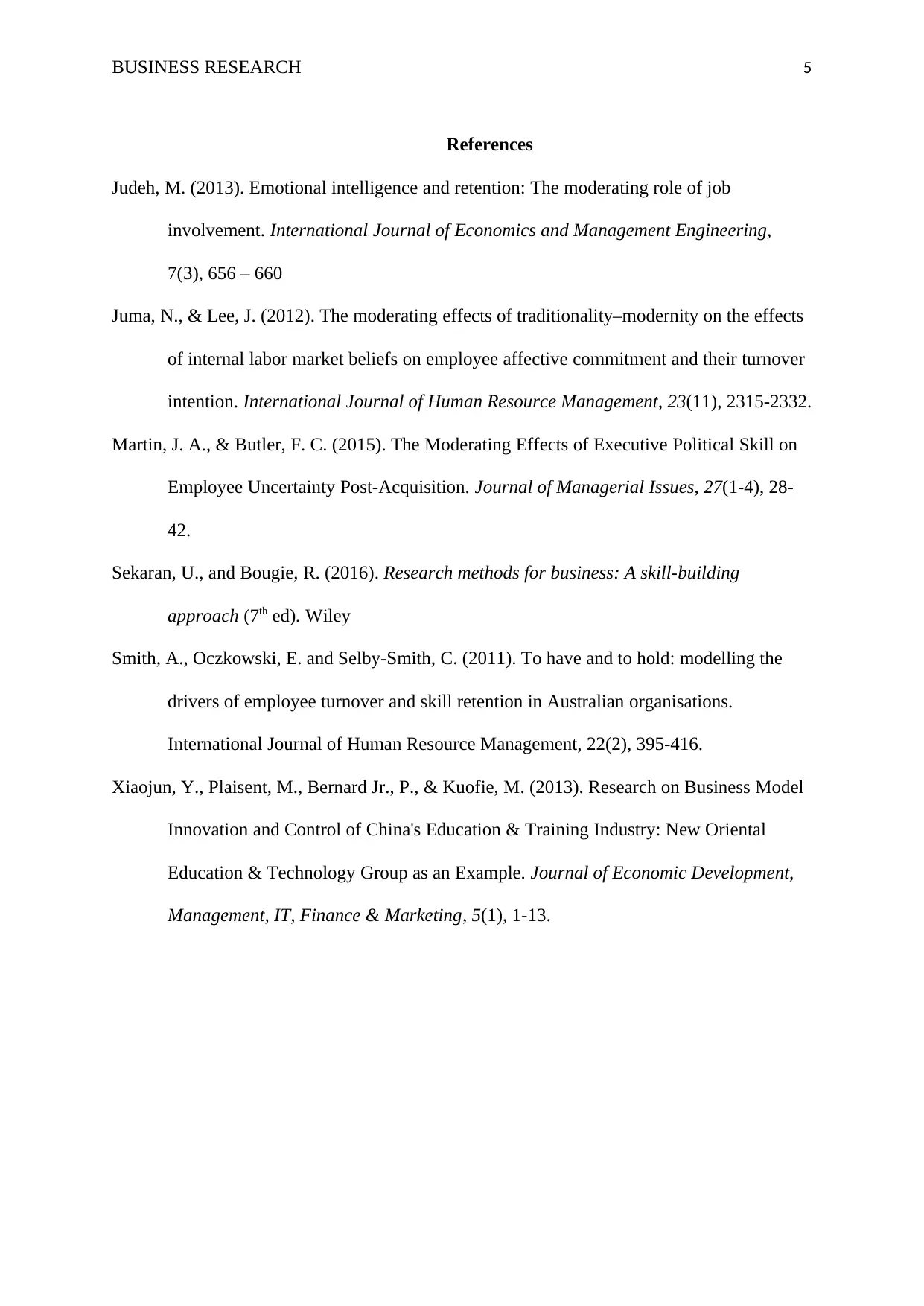Business Research Report: Variables, Frameworks, and Measurement
VerifiedAdded on 2021/05/30
|5
|1122
|184
Report
AI Summary
This report analyzes the variables used in a business research study, specifically focusing on employee turnover and skill retention within Australian companies. The study, conducted by Smith, Oczkowski, and Selby-Smith (2011), explores the relationships between dependent variables (employee turnover and skill retention) and independent variables (lean production, total quality management, and learning orientation). The report defines these variables, explains the motivation for their inclusion in the study's conceptual framework, and discusses how they were measured. Furthermore, the report suggests the inclusion of moderating variables, such as employee involvement, to refine the relationship between independent and dependent variables. The research emphasizes the importance of management philosophies in influencing employee outcomes and highlights the need to differentiate between traditional HR practices and underlying management approaches. The study utilizes a variety of measurement techniques to quantify both dependent and independent variables, and references relevant literature to support the analysis.

Running Head: BUSINESS RESEARCH
MGT598 - Business Research
Student Name:
Student Number:
Module Code:
Submission Date:
MGT598 - Business Research
Student Name:
Student Number:
Module Code:
Submission Date:
Paraphrase This Document
Need a fresh take? Get an instant paraphrase of this document with our AI Paraphraser

BUSINESS RESEARCH 2
1. Variables in the study and How they are defined
Sekaran and Bougie (2016) categorizes variables into dependent, independent,
moderating, mediating. After reading the journal article, it is clear that Smith, Oczkowski and
Selby-Smith (2011) theoretical framework covers two dependent variables – the employee
turnover and the level of confidence to retain high levels of skills. For example, they defines
employee turnover as a percentage annual average for a period of three years. They also
defined skill retention as the degree at which organisations understudy are able to utilise
skills of employees and consequently, achieve long-term goals.
Apart from the dependent variables, Smith, et al. also used independent variables to
influence dependent variables either positively or negatively. In essence, the study sought to
examine drivers that enhance a high level of employee turnover and skill retention among
employees working in more than 300 Australian companies. The authors selected three
independent variables that they believed could help achieve-high performance work in
organisations under study. In specific, they focused on management philosophies that
associated with higher performance; lea production (LP), total quality management (TQM),
and learning orientation (LO).
Smith, et al. defined LP as a number of activities that takes place within an
organisation that management use to create and enhance knowledge among employees.
Consequently, management use these activities when they understand that they are operating
in a dynamic market where competitive advantage remains important in achieving long-term
goals. Second, they defined TQM as a management philosophy that helps an organisation to
continue recording positive performance through different processes, products and services.
Besides, they adopted items used by other researchers.
1. Variables in the study and How they are defined
Sekaran and Bougie (2016) categorizes variables into dependent, independent,
moderating, mediating. After reading the journal article, it is clear that Smith, Oczkowski and
Selby-Smith (2011) theoretical framework covers two dependent variables – the employee
turnover and the level of confidence to retain high levels of skills. For example, they defines
employee turnover as a percentage annual average for a period of three years. They also
defined skill retention as the degree at which organisations understudy are able to utilise
skills of employees and consequently, achieve long-term goals.
Apart from the dependent variables, Smith, et al. also used independent variables to
influence dependent variables either positively or negatively. In essence, the study sought to
examine drivers that enhance a high level of employee turnover and skill retention among
employees working in more than 300 Australian companies. The authors selected three
independent variables that they believed could help achieve-high performance work in
organisations under study. In specific, they focused on management philosophies that
associated with higher performance; lea production (LP), total quality management (TQM),
and learning orientation (LO).
Smith, et al. defined LP as a number of activities that takes place within an
organisation that management use to create and enhance knowledge among employees.
Consequently, management use these activities when they understand that they are operating
in a dynamic market where competitive advantage remains important in achieving long-term
goals. Second, they defined TQM as a management philosophy that helps an organisation to
continue recording positive performance through different processes, products and services.
Besides, they adopted items used by other researchers.

BUSINESS RESEARCH 3
2. Motivation For Including These Variables Into The Conceptual Framework For
The Study
Sekaran and Bougie (2016) explain that researchers use theoretical frameworks to
show how variables and concepts connect to one another. Furthermore, explain that studies
that the process of building a good framework involves introducing definitions to a number of
concepts or variables, developing a conceptual model, then formulating a theory that explain
the relationship between the variables (Xiaojun, et al., 2013). After reviewing the journal
article by Smith, et al., (2011), it is evident that the framework involved finding out a number
of factors that determines a high level of employee turnover and skill retention to achieve
both short term and long term goals. They argue that while other studies have used a list of
practices that already falls under human resource management and training, there was a need
to look at some of the underlying philosophies of management that contributes towards high
performance of systems.
Besides, the authors were motivated to differentiate between conventional measure of
turnover as skill retention by uncovering drivers of retention likely to create long-term
performance and not short-term performance. Second, they argue that previous philosophies
of management focused only on one measure of human resource practises. Therefore, they
needed to incorporate management philosophies that underline higher performance among
employees, systems, and HRM practices. Furthermore, they sought to understand the degree
of contribution of turnover models.
2. Motivation For Including These Variables Into The Conceptual Framework For
The Study
Sekaran and Bougie (2016) explain that researchers use theoretical frameworks to
show how variables and concepts connect to one another. Furthermore, explain that studies
that the process of building a good framework involves introducing definitions to a number of
concepts or variables, developing a conceptual model, then formulating a theory that explain
the relationship between the variables (Xiaojun, et al., 2013). After reviewing the journal
article by Smith, et al., (2011), it is evident that the framework involved finding out a number
of factors that determines a high level of employee turnover and skill retention to achieve
both short term and long term goals. They argue that while other studies have used a list of
practices that already falls under human resource management and training, there was a need
to look at some of the underlying philosophies of management that contributes towards high
performance of systems.
Besides, the authors were motivated to differentiate between conventional measure of
turnover as skill retention by uncovering drivers of retention likely to create long-term
performance and not short-term performance. Second, they argue that previous philosophies
of management focused only on one measure of human resource practises. Therefore, they
needed to incorporate management philosophies that underline higher performance among
employees, systems, and HRM practices. Furthermore, they sought to understand the degree
of contribution of turnover models.
⊘ This is a preview!⊘
Do you want full access?
Subscribe today to unlock all pages.

Trusted by 1+ million students worldwide

BUSINESS RESEARCH 4
3. Variable measurement
Variable measurement starts in the early stages when developing a framework by
identifying the items and things to count (Sekaran and Bougie, 2016). According to Juma and
Lee (2012), researchers measure variables based on their nature in terms of ordinal, normal,
or numerical. The review of the journal shows that Smith, et al. (2011, p. 399) measured
employee turnover in terms of management level (such as senior, middle, or lower managers,
as profession or engineering technician. the second category of item included the skill level
like plumber or electrician. While the skill for retention was measured using four items. In
overall, they measured two dependent variables using 20 items. Apart from dependent
variables, they grouped independent variables as key drivers to turnover and skill retention
within organisational/market characteristics, training practices, high performance work
system practises, and human resource management practises.
4. Other important variables to include in the study
The study could also include moderating variables to create contingent effect the
relationship between the independent and dependent variable (Judeh, 2013). A moderating
variable such as employee involvement would act as a third variable in order to modify the
original relationship between LP, TQM, and LO and employee turnover and skill retention.
Management might therefore, need to design a questionnaire that incorporates questions that
measures six items (Martin and Butler, 2015).
3. Variable measurement
Variable measurement starts in the early stages when developing a framework by
identifying the items and things to count (Sekaran and Bougie, 2016). According to Juma and
Lee (2012), researchers measure variables based on their nature in terms of ordinal, normal,
or numerical. The review of the journal shows that Smith, et al. (2011, p. 399) measured
employee turnover in terms of management level (such as senior, middle, or lower managers,
as profession or engineering technician. the second category of item included the skill level
like plumber or electrician. While the skill for retention was measured using four items. In
overall, they measured two dependent variables using 20 items. Apart from dependent
variables, they grouped independent variables as key drivers to turnover and skill retention
within organisational/market characteristics, training practices, high performance work
system practises, and human resource management practises.
4. Other important variables to include in the study
The study could also include moderating variables to create contingent effect the
relationship between the independent and dependent variable (Judeh, 2013). A moderating
variable such as employee involvement would act as a third variable in order to modify the
original relationship between LP, TQM, and LO and employee turnover and skill retention.
Management might therefore, need to design a questionnaire that incorporates questions that
measures six items (Martin and Butler, 2015).
Paraphrase This Document
Need a fresh take? Get an instant paraphrase of this document with our AI Paraphraser

BUSINESS RESEARCH 5
References
Judeh, M. (2013). Emotional intelligence and retention: The moderating role of job
involvement. International Journal of Economics and Management Engineering,
7(3), 656 – 660
Juma, N., & Lee, J. (2012). The moderating effects of traditionality–modernity on the effects
of internal labor market beliefs on employee affective commitment and their turnover
intention. International Journal of Human Resource Management, 23(11), 2315-2332.
Martin, J. A., & Butler, F. C. (2015). The Moderating Effects of Executive Political Skill on
Employee Uncertainty Post-Acquisition. Journal of Managerial Issues, 27(1-4), 28-
42.
Sekaran, U., and Bougie, R. (2016). Research methods for business: A skill-building
approach (7th ed). Wiley
Smith, A., Oczkowski, E. and Selby-Smith, C. (2011). To have and to hold: modelling the
drivers of employee turnover and skill retention in Australian organisations.
International Journal of Human Resource Management, 22(2), 395-416.
Xiaojun, Y., Plaisent, M., Bernard Jr., P., & Kuofie, M. (2013). Research on Business Model
Innovation and Control of China's Education & Training Industry: New Oriental
Education & Technology Group as an Example. Journal of Economic Development,
Management, IT, Finance & Marketing, 5(1), 1-13.
References
Judeh, M. (2013). Emotional intelligence and retention: The moderating role of job
involvement. International Journal of Economics and Management Engineering,
7(3), 656 – 660
Juma, N., & Lee, J. (2012). The moderating effects of traditionality–modernity on the effects
of internal labor market beliefs on employee affective commitment and their turnover
intention. International Journal of Human Resource Management, 23(11), 2315-2332.
Martin, J. A., & Butler, F. C. (2015). The Moderating Effects of Executive Political Skill on
Employee Uncertainty Post-Acquisition. Journal of Managerial Issues, 27(1-4), 28-
42.
Sekaran, U., and Bougie, R. (2016). Research methods for business: A skill-building
approach (7th ed). Wiley
Smith, A., Oczkowski, E. and Selby-Smith, C. (2011). To have and to hold: modelling the
drivers of employee turnover and skill retention in Australian organisations.
International Journal of Human Resource Management, 22(2), 395-416.
Xiaojun, Y., Plaisent, M., Bernard Jr., P., & Kuofie, M. (2013). Research on Business Model
Innovation and Control of China's Education & Training Industry: New Oriental
Education & Technology Group as an Example. Journal of Economic Development,
Management, IT, Finance & Marketing, 5(1), 1-13.
1 out of 5
Related Documents
Your All-in-One AI-Powered Toolkit for Academic Success.
+13062052269
info@desklib.com
Available 24*7 on WhatsApp / Email
![[object Object]](/_next/static/media/star-bottom.7253800d.svg)
Unlock your academic potential
Copyright © 2020–2025 A2Z Services. All Rights Reserved. Developed and managed by ZUCOL.





